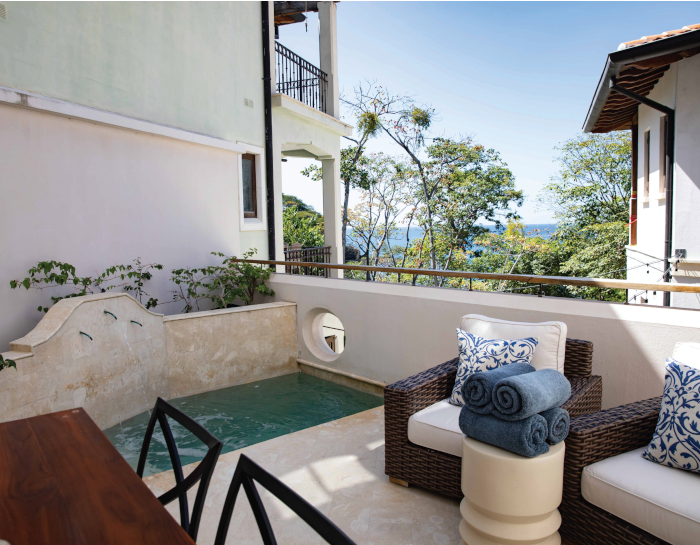Pura Vida
By Contributor
By Contributor


“We are the real deal,” Charles Brewer says confidently. “The car-freeness is what makes this place unique. Being here makes you a nicer person.”
After spending a long weekend at Las Catalinas, I am convinced that he literally walks the walk, embodying the local pura vida, or pure life, culture.
Brewer, an Atlanta-based entrepreneur and founder of the dotcom MindSpring Enterprise, is the real estate developer behind Las
Catalinas. The 1,200-acre seaside utopia, located on the Guanacaste Coast of Costa Rica, is reminiscent of medieval hill towns like Cinque Terre, Italy and Ronda, Spain.

Brewer confesses his priorities have shifted with age. In contrast to his former swashbuckling life on the road, he’s now a grandfather with desires to live at a slower, gentler pace. He relishes time spent with his grandchildren in an environment where they can roam with sheer abandon. He calls it “kid freedom”—a term that encompasses how he once felt as a child in a bygone era. For Brewer, it was a time when community, wellness, and nature were highly valued.
Rooted in lessons of how cities and towns have been built for centuries, Las Catalinas is inspired by a movement known as New Urbanism. The goal is to foster more human-to-human and human-to-nature contact by designing spaces that are walkable and accessible.
“We are ultra local,” declares Sara Bega, Las Catalinas’ town architect. “Our most important value is sociability.”
Bega is a protégée of Douglas Duany, renowned professor at the University of Notre Dame and Las Catalinas’ maiden architect. The school remains a valued asset to the town, with a continued partnership where students can spend their fifth year on site to aid in its emerging design.
Las Catalinas is inhabited by expats from around the globe. Its ultimate goal is to maintain a population of 40 percent full-time residents and 180 residences. While 25 miles of trails have been built for hiking and biking, a thousand acres of unspoiled land will remain in place, serving as a nature preserve.
Within the town, cobblestone streets lead the way to a diverse and colorful mix of buildings, from 350-square-foot studios to Colonial- style castles—all interspersed with shopping plazas and parks. Casa Azul, the private villa at which I stayed, is true to its name— vibrant, azure-toned, and facing the ocean. Maria, the house mom, welcomed guests with a molcajete of her verdant guacamole and fresh lemonade. The laughter of neighbors could be heard, making me take notice of how the villas are designed to invite guests to commune with one another.
Many of the design materials at Las Catalinas are locally sourced and built in-house. Third-generation woodworkers constructed the wood floors with teak, and pergolas were made of Guanacaste wood and cana brava, or sugar cane. Custom woven furniture and vibrant hand sewn pillows and linens are designed and manufactured in a local workshop. Andrina Fonseca, owner of D-Aqui Design insisted on bringing both the design and manufacturing of tiles onto the premises. Visitors enamored of the villas can shop at her studio for authentic Costa Rican interiors made by trusted artisans.
A unique aspect of Las Catalinas is that it caters to a diverse mix of visitors. The Beach Club boasts a pool for families (offering swim
lessons), a 25-meter lap pool for serious swimmers, and a majestic infinity pool from which couples can watch the sunset.
Serious athletes participate in The Las Catalinas Triathlon and the annual Pura Vida Ride Paddle Battle, the town’s oldest event. Locals and visitors cruise the vast trails on bike and foot while surfers catch the morning sets. The Pura Vida Ride Shop is a haven for sports enthusiasts specializing in sales and rentals of paddleboards, kayaks, mountain bikes, and guided tours.
For those seeking less activity and more respite, the WAKE day spa offers facials, body treatments, and even a small boutique. True shoppers can also browse haute interiors at D-Aqui Design or wander a few doors down to LaPula for local fashion and jewelry. Expect to be greeted with “pura vida” by every local who passes. There is always the option of snoozing to the percussive crash of the waves from a hammock on secluded Playa Dantita.
Gastronomes will also feel as if they’re in paradise. The upscale Copper and Stone Market stocks organic produce, gluten-free baked goods, juices and smoothies, artisan sandwiches, and small batch beers on draft. Downstairs at La Cava, one of the most recognized wine caves in Costa Rica, Chef Damian Geneau offered flutes of Freixenet Cava and wool shawls to keep chills at bay.
At Limonada, the signature beachside restaurant on Playa Danta, casual elegance is the theme. We started with housemade dips, including black bean and buffalo chickpea puree. And a tantalizing coconut ceviche was prepared by a familiar face—the chef, Gilberto, was spotted earlier on the beach, foraging edible herbs like verdolaga (purslane).
Our hostess Nina Lora planned a lunch the following day with diving instructor Ernst van der Poll of ConnectOcean. Born in South Africa and educated at MIT, van der Poll—a former diving instructor for the Crown Prince of Dubai— uses scuba diving, guided expeditions, and swim classes as an opportunity to educate guests about environmental policies and social responsibility.
I spent my final afternoon on Playa Danta, taking a kayak out to sunbathe on the floating dock, and finished with a sunset trail hike led by Community Affairs Director Michael Garcia. Garcia expertly identified native species of plants and their medicinal uses. When we reached the summit, with a picturesque view of the sea and the town, Brewer’s message rang true. Las Catalinas is the real deal.
For more information, visit lascatalinascr.com.


Sign Up for the JWC Media Email